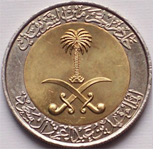|


The Riyal (ISO 4217 code: SAR) is the currency of Saudi Arabia. It is abbreviated as ?.? or SR (Saudi Riyal). It is subdivided into 100 Halalas. The Saudi Ghirsh is 5 Halalas.
History
The riyal has been the currency of Saudi Arabia since the country came in to being and was the currency of Hejaz before Saudi Arabia was created. The Hejaz riyal was based on (though not equivalent to) the Ottoman 20 kurus coin and was consequently divided into 20 ghirsh. However, although the Hejaz riyal was the same weight as the Ottoman 20 kurus, it was minted in .917 fineness, compared to .830 fineness for the Ottoman coin. Thus, because the first Saudi riyal had the same specifications as the Hejaz riyal and circulated alongside Ottoman coins, it came to be worth 22 Ottoman kurus and was consequently subdivided into 22 ghirsh when coins denominated in ghirsh were issued from 1925. This remained the system of currency even though the riyal was subsequently debased to a coin equivalent in silver content to the Indian rupee in 1935.
Note that the Latin alphabet spelling "ghirsh" rather than "qirsh" reflects the pronunciation in Saudi Arabia, while in the Arabic script the spelling was the same as used elsewhere.
In 1960, the system was changed to 20 ghirsh = 1 riyal and this was followed in 1963 by the introduction of the halala, worth one hundredth of a riyal. Some Saudi coins still bear denominations in ghirsh but this denomination is no longer commonly used.
For a wider history surrounding currency in the region, see The History of British Currency in the Middle East.
Coins
In 1925, transitional copper coins for ¼ and ½ ghirsh were minted in Mecca by `Abd al-`Aziz Al Sa`ud. These were followed, in 1926, by ¼, ½ and 1 ghirsh pieces minted in cupro-nickel, carrying the title "King of Hejaz and Sultan of Nejd".
In 1927, the royal title was changed to "King of Hejaz and Nejd and Dependencies" and coins were issued in denominations of ¼, ½ and 1 ghirsh in cupro-nickel and ¼, ½ and 1 riyal in silver.
In 1935, the first coins were issued in the name of Saudi Arabia. These were silver ¼, ½ and 1 riyal coins which were nearly 50% lighter than the previous issue. Cupro-nickel ¼, ½ and 1 ghirsh were also issued from 1937. In 1946 (AH 1365), many of the cupro-nickel coins were countermarked with the Arabic numerals 65 in what Krause and Mishler describe as "a move to break money changers' monopoly on small coins". Cupro-nickel 2 and 4 ghirsh were introduced in 1957.
In 1963, the halala was introduced and bronze 1 halala coins were issued. This was the only year these coins were struck. Cupro-nickel 5, 10, 25 and 50 halala followed in 1972. These coins are also inscribed with their denomination in ghirsh or riyal (1, 2 ghirsh, ¼, ½ riyal). In 1976, cupro-nickel 1 riyal coins were introduced, which are also inscribed with the denomination 100 halala. Bimetallic 1 riyal coins were issued in 1999.
In 2007 (AH 1428), a 50 halala coin was introduced,bearing the name of King Abdullah.
Banknotes
In 1953, the Saudi Arabian Monetary Agency (SAMA) began issuing Haj Pilgrim Receipts for 10 riyals , with 1 and 5 riyals following in 1954 and 1956, respectively. These resembled banknotes and were initially intended for use by pilgrims who exchanged foreign currency for them. However, they became widely accepted in Saudi Arabia and largely replaced silver riyal coins in major financial transactions. Consequently, the Monetary Agency began issuing regular banknotes for 1, 5, 10, 50 and 100 riyal in 1961, with the Pilgrim Receipts being demonetized in 1964.
500 Riyal notes were introduced in 1983. 20 and 200 riyal banknotes were issued in 2000 to commemorate the centenary of the founding of what became the Kingdom of Saudi Arabia.
SAMA has announced that a new series of banknotes bearing the face of King Abdullah will be issued starting in April, 2007.
Fifth issue
On May 20, 2007, "the Saudi Arabian Monetary Agency, pursuant to article (4) of the Saudi Currency Law, issued under the Royal Decree No. (6) and dated 1/7/1379H." announced the fifth domination of the Saudi Riyal that features King Abdullah Bin Abdulaziz's picture on all notes except the 500 riyal, which features the late King Abdulaziz Al Saud. The 100 and 50 riyal notes were released on May 21, 2007. The 10 and 5 riyal notes followed on June 2007, then the 500 riyal followed on September 2007, and finally the 1 riyal note completed the series on December 2007. It is expected by the SAMA that the fourth (current) series will take approximately two years to phase out, although a complete removal of the current series require more than two years since the fourth series has been in circulation for well over 20 years. The fourth series which feature late King Fahad's picture will remain legal tender under the Saudi Arabian monetary law. The new series will have the latest and most advanced security system to prevent from counterfeiting and other similar activities.
Fixed exchange rate
In June 1986, the riyal was officially pegged to the IMF's Special Drawing Rights (SDRs). In practice, it is fixed at 1 U.S. dollar = 3.75 riyals, which translates to approximately 1 riyal = 0.266667 dollar.This rate was made official on January 1, 2003.
The riyal briefly rose to a 20-year high after the Federal Reserve cut interest rates on September 18, 2007 and the Saudi Arabian Monetary Agency chose not to follow suit, partially due to concerns about the inflationary effects low interest rates and a lower value for the riyal.The riyal returned to its peg against the U.S. dollar in early December of 2007.
The text on this page has been made available under the Creative Commons Attribution-ShareAlike License and Creative Commons Licenses
| 